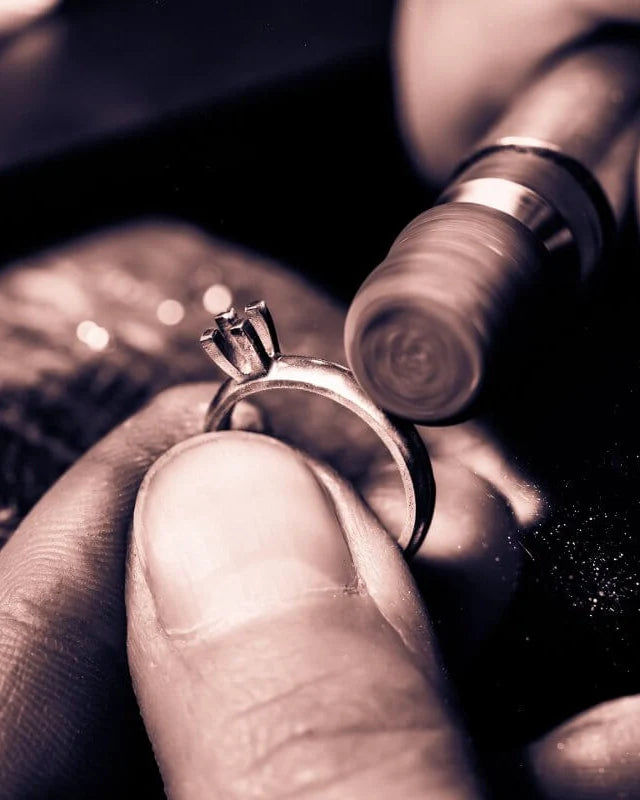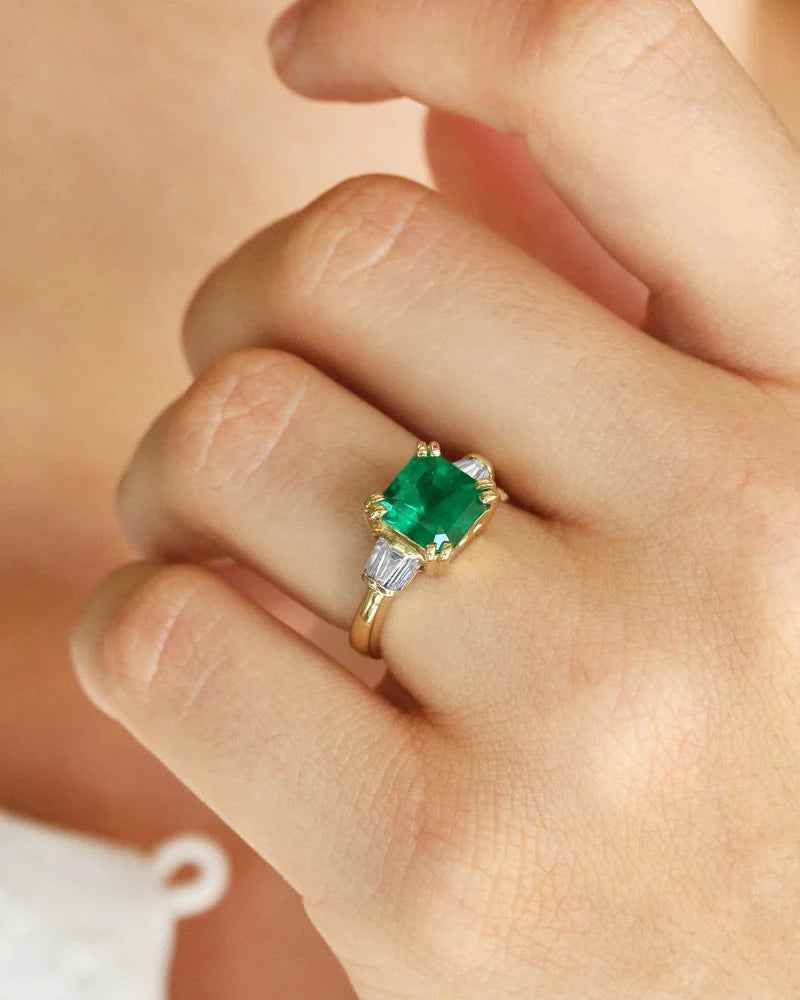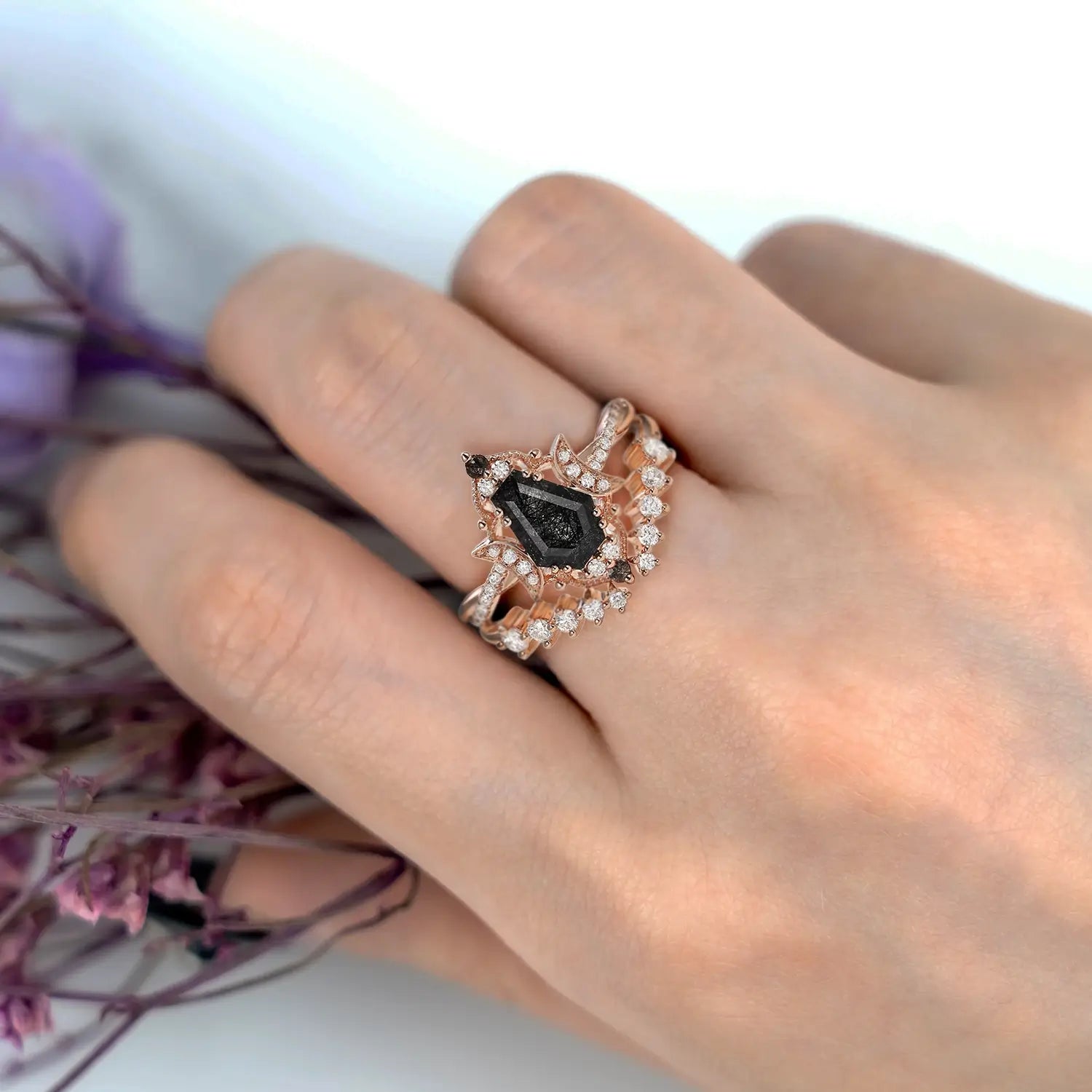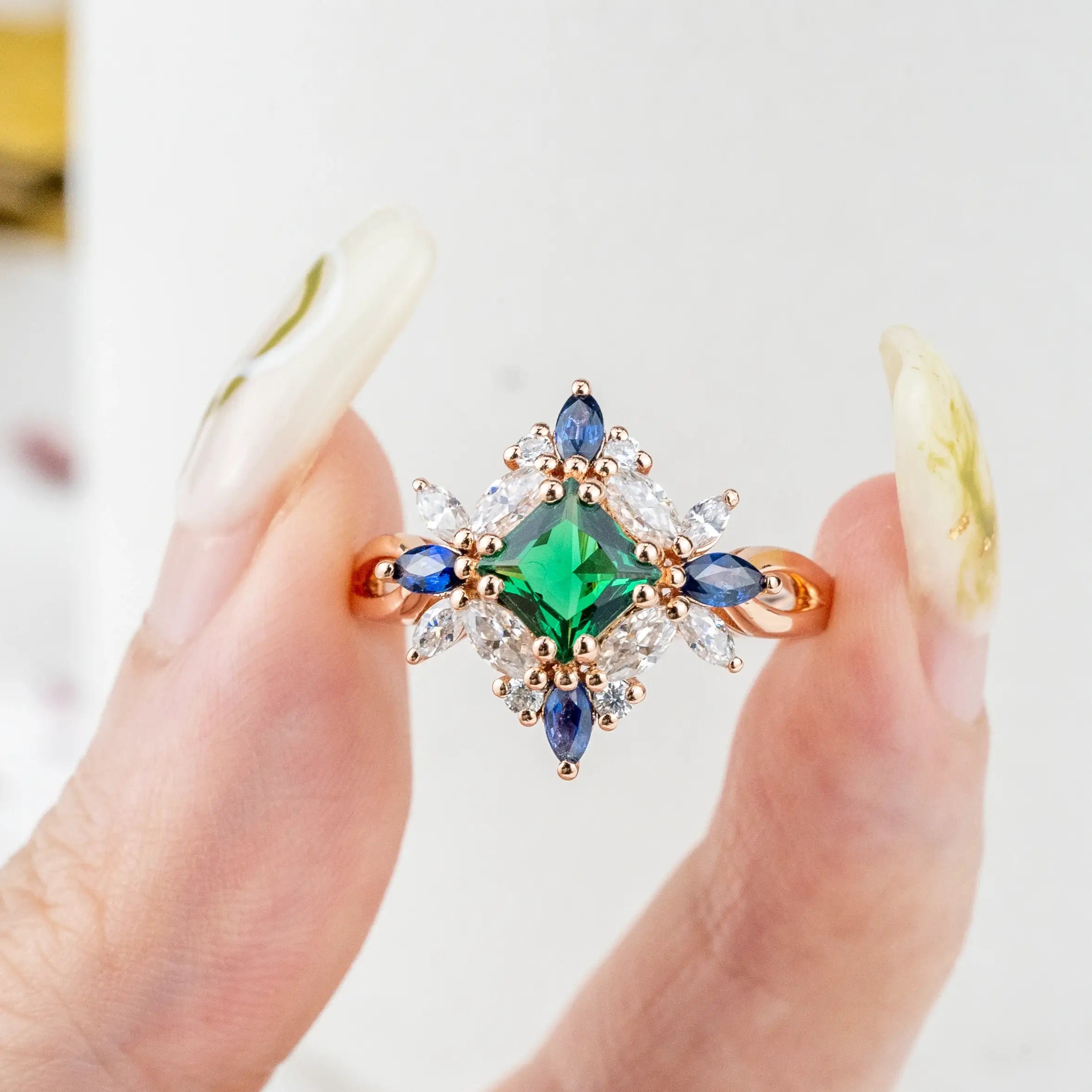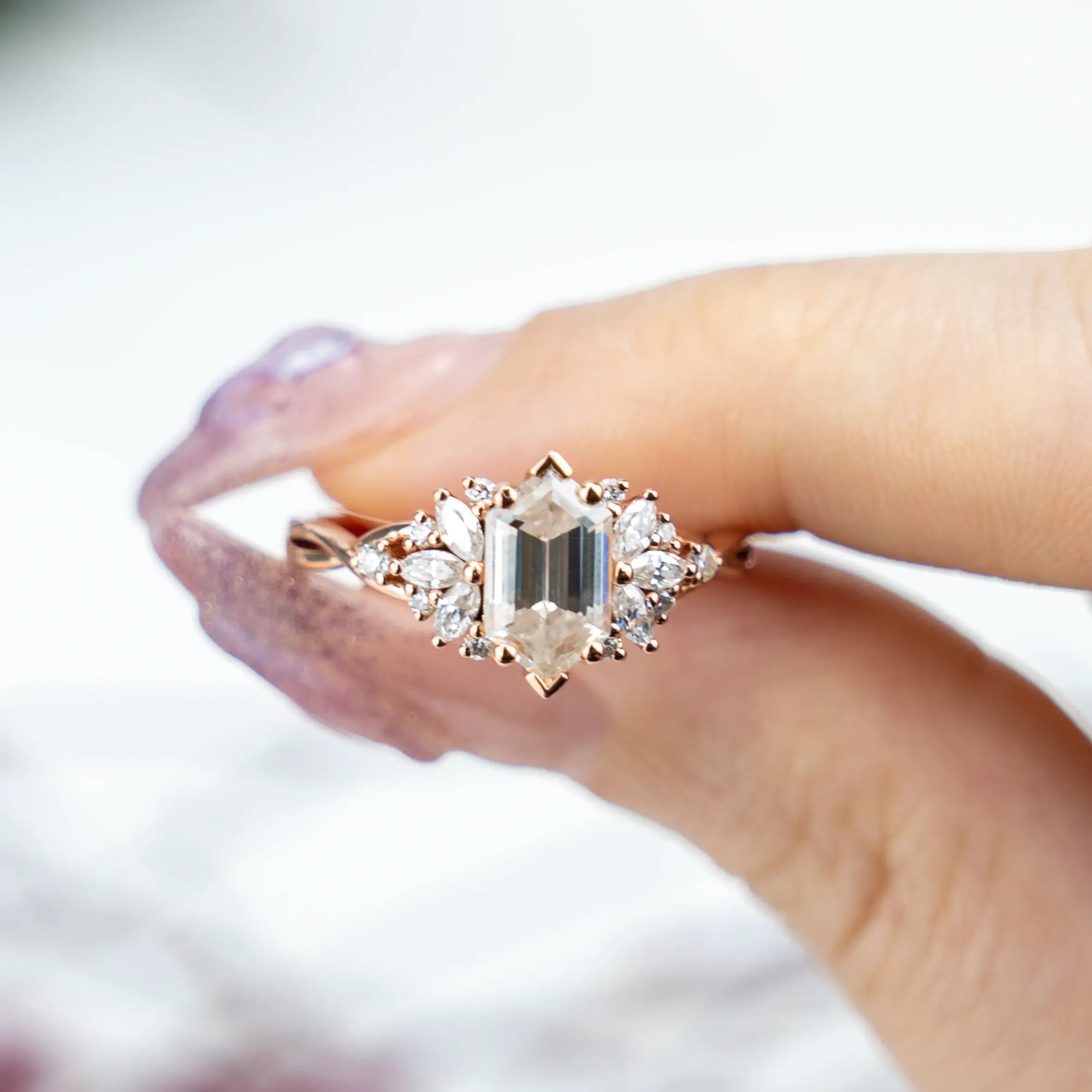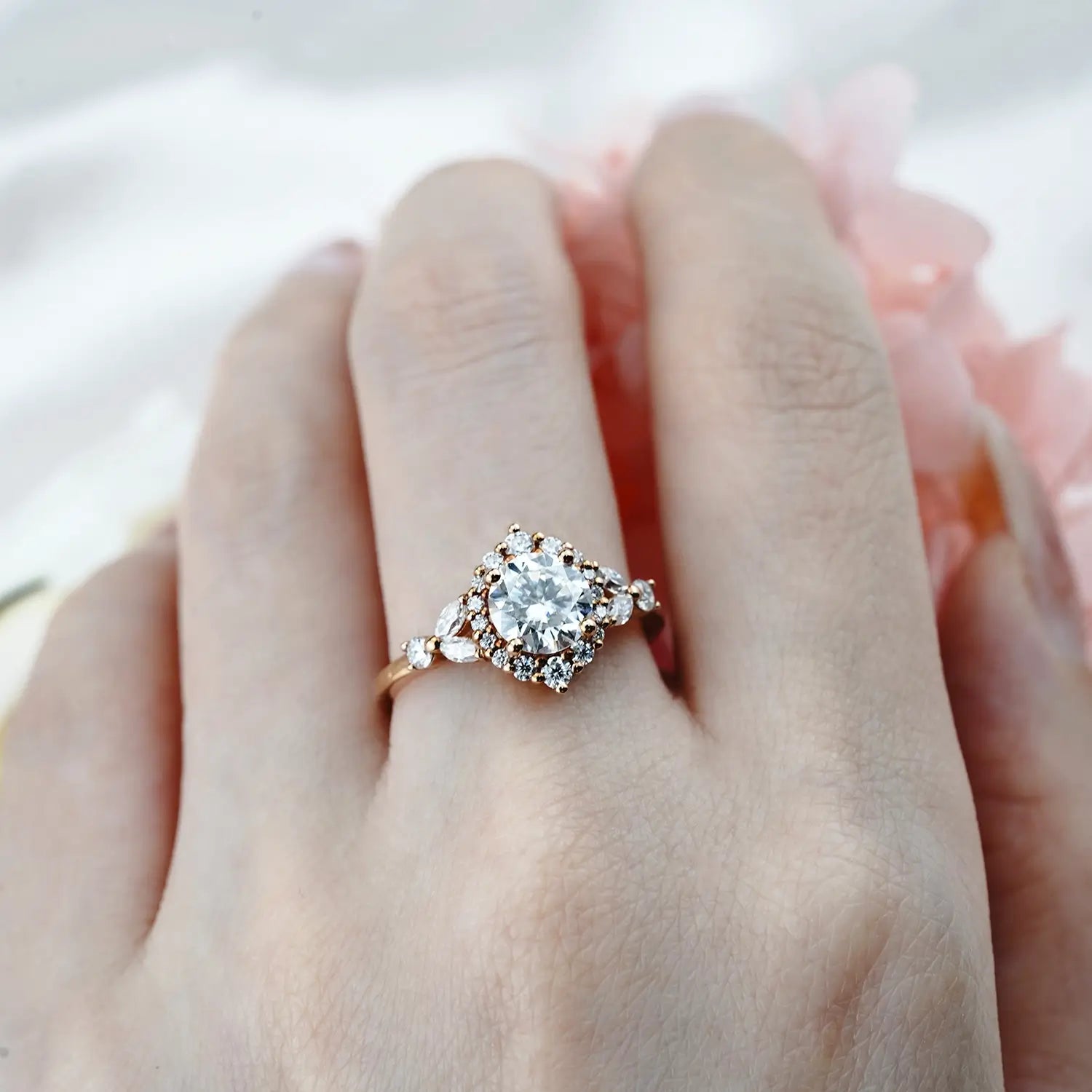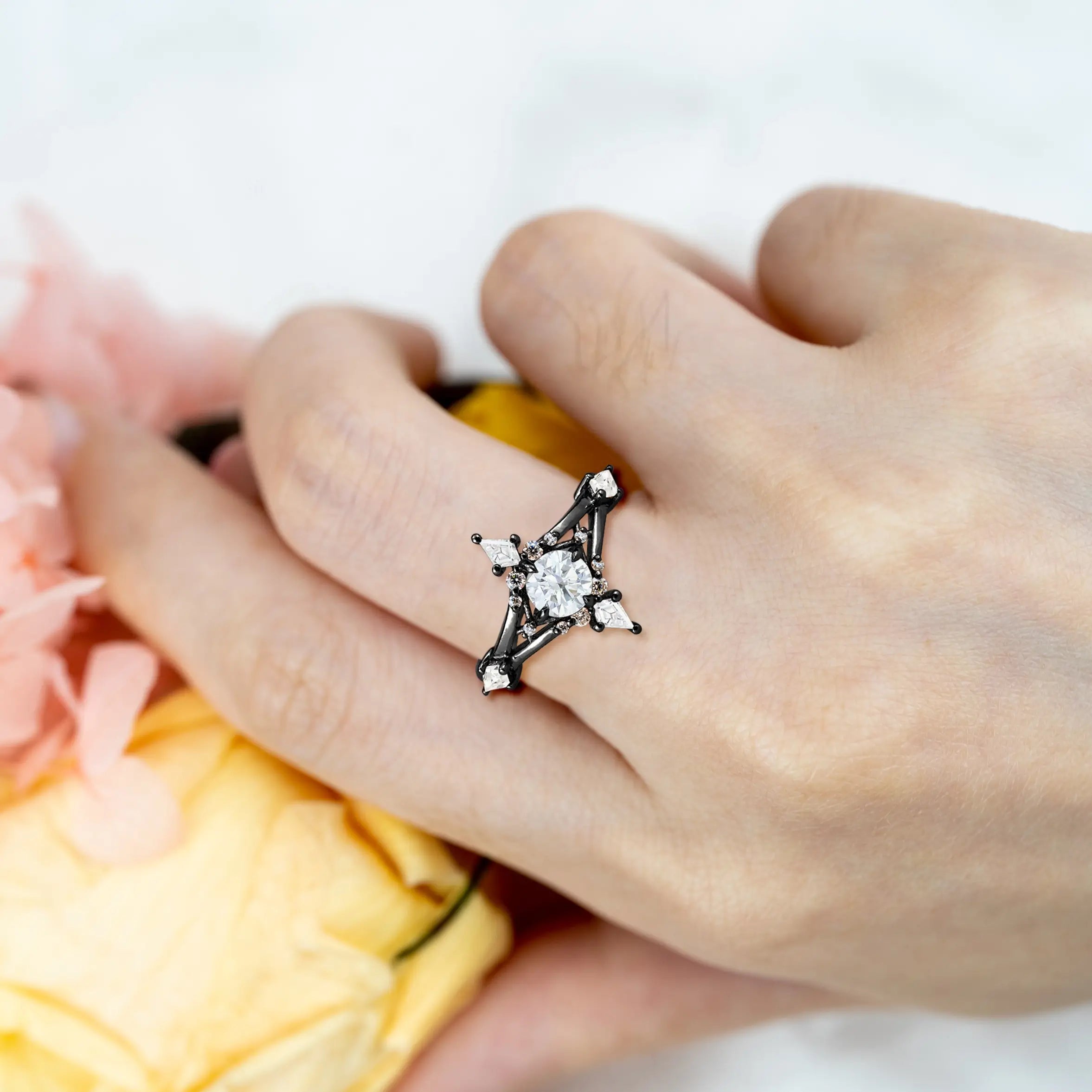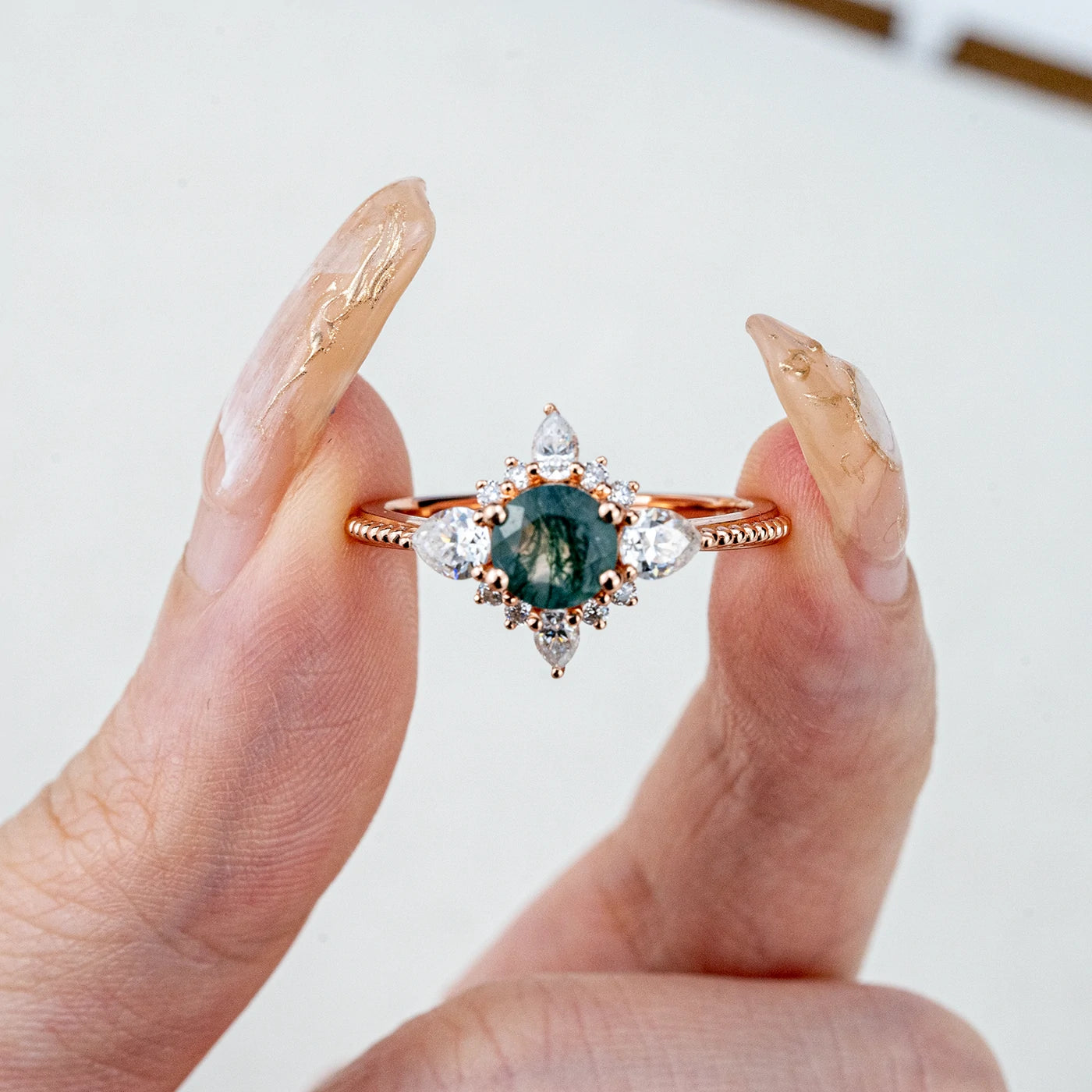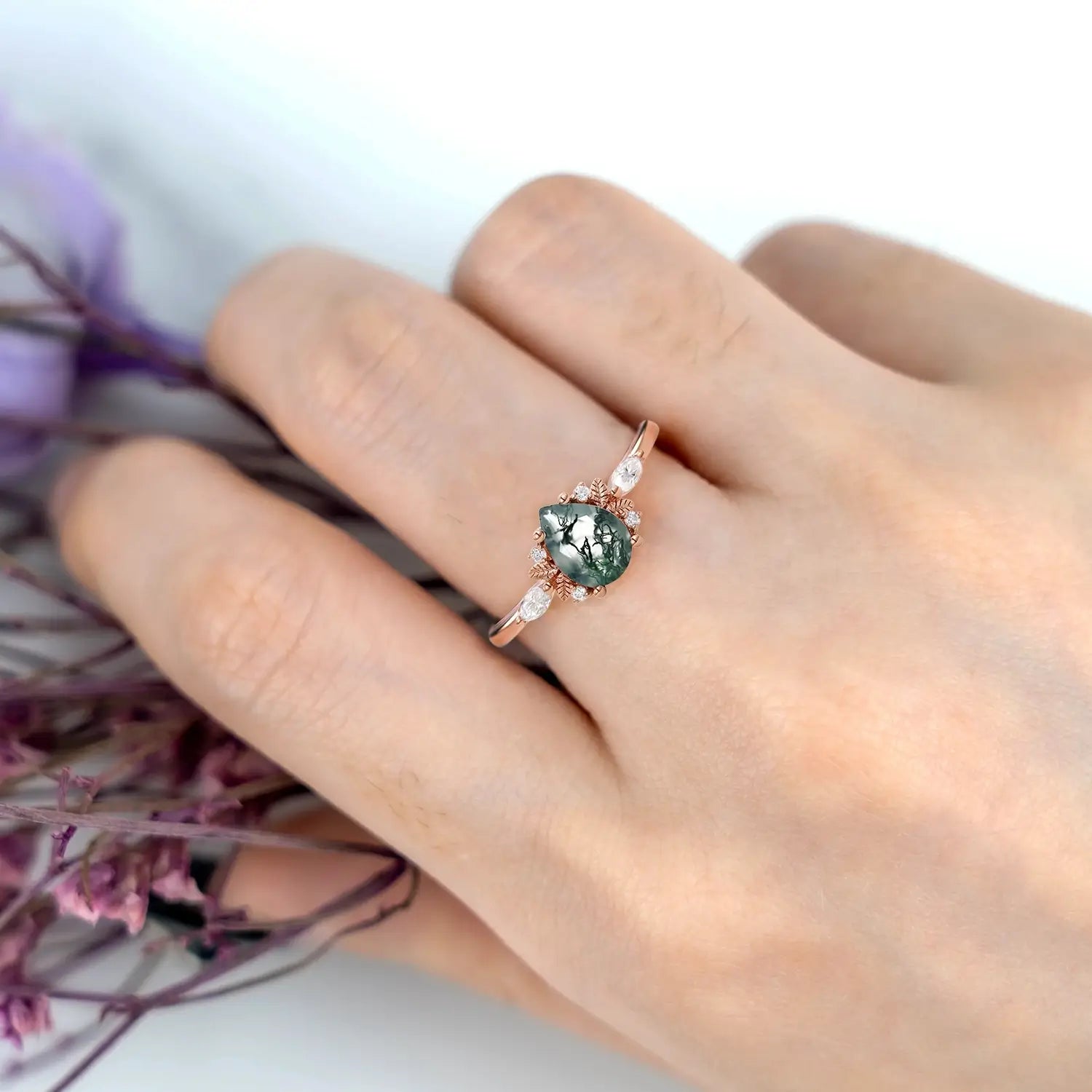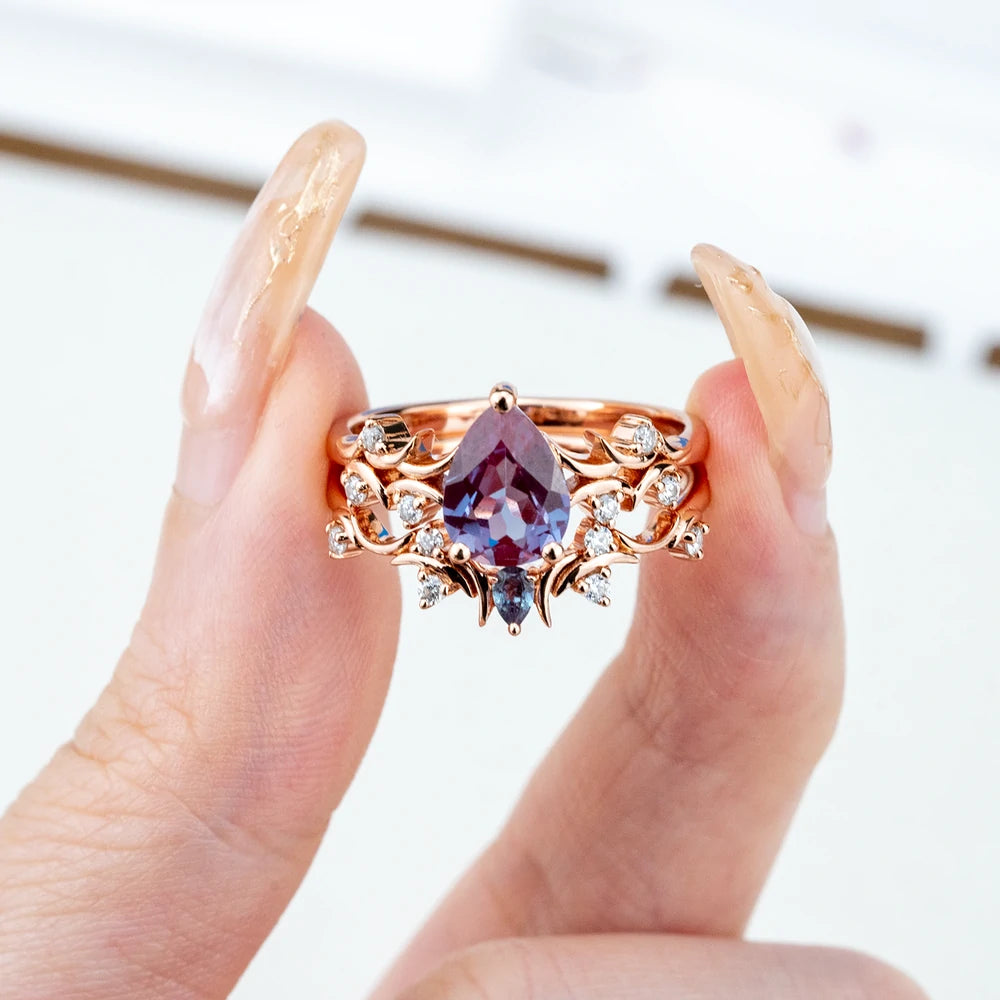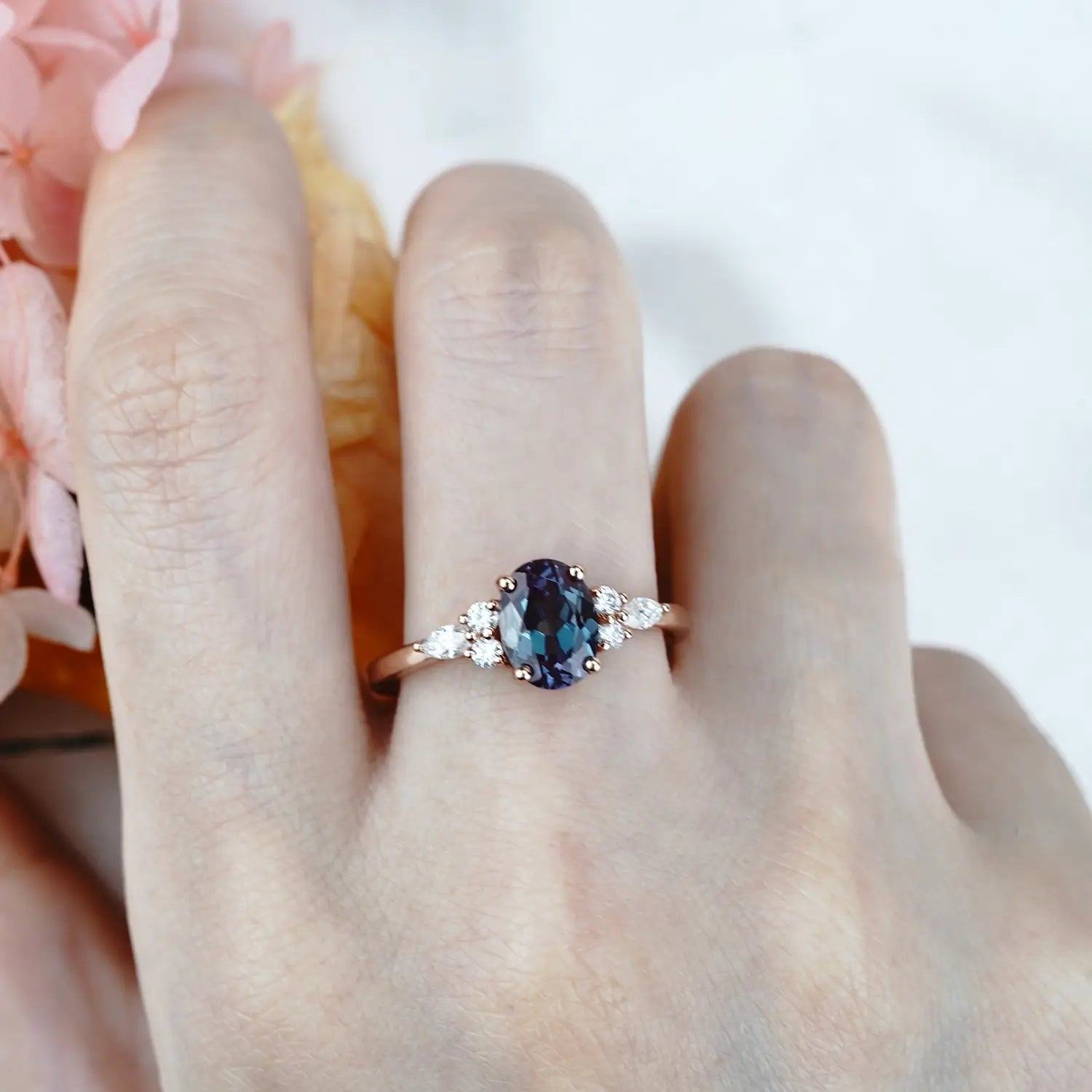Choosing a custom engagement ring is like writing your love story in gold and stone. Each handcrafted detail—leafy motifs, unusual gemstones, or a vintage engraving—becomes a chapter of your relationship. Today’s couples aren’t satisfied with off-the-shelf promises; they want a ring as unique as their bond. In fact, searches for custom gemstone engagement rings and unique moissanite ring for her are on the rise, reflecting a desire to break from tradition. By designing a ring together, you capture your personal journey, not just a trend.
For generations, engagement rings have symbolized devotion. In ancient Rome, betrothal rings were simple hoops, but by the Renaissance they began featuring gems . The first recorded diamond ring was given by Archduke Maximilian of Austria in 1477 to Mary of Burgundy , setting off a trend of diamond-studded promises. In the 20th century, De Beers’ “A Diamond is Forever” campaign forever tied diamonds to romance . Yet today, many couples yearn to chart their own course. Custom rings let you blend history and innovation—perhaps a moss agate stone with Victorian-style filigree or a rose-gold band shaped like vine leaves. In this guide, we’ll explore how to make that vision real: from choosing gemstones to understanding styles, timelines, and budgets. Along the way we’ll share insights and answer top questions so you can design a ring that truly lives forever.
A Brief History of Engagement Rings: From Ancient Symbol to Modern Muse
Since the Roman Empire, engagement rings have marked formal promises . Originally a simple token, the ring’s design evolved over centuries. During the Renaissance and later Victorian era, gems like rubies and sapphires appeared in posy rings and filigree bands. The Archduke Maximilian’s 1477 diamond ring introduced the notion of a diamond as the ultimate vow symbol. Over time, diamond jewelry trickled down from royalty to the masses (after diamonds were discovered in South Africa and production skyrocketed). A pivotal 20th-century campaign taught Americans that every engagement ring needed a diamond, exploding diamond sales from $23 million to $2.1 billion between 1939 and 1979 .
Yet the 21st century is seeing a renaissance of its own. Modern couples honor tradition while writing new rules. Lab-grown diamonds, colorful gemstones, and even nontraditional materials have become acceptable and admired. Google Trends shows lab-grown diamonds outpacing natural ones in search interest (69% to 31%) (Top Engagement Ring Trends for 2024: Lab-Made Diamonds and Color Gemstones Shine Bright), and colorful gems are “top of mind” for ring buyers . The rise of searches like “best gemstones for engagement rings” and “unique gemstone engagement rings” reflects a broader acceptance of personalization. In short, engagement rings have always been about love; now they’re also about identity. You can honor history — perhaps by choosing a Victorian-inspired halo — or forge a new tradition with an emerald-cut moss agate or a custom moissanite.
Why Custom? The Emotional and Artistic Value of Personalized Design

Designing a custom ring is an intimate act. Unlike a generic solitaire, a bespoke ring carries your fingerprints, both literal and symbolic. Imagine sketching a band together with your partner, selecting a birthstone or a moss agate because of its forested green veining — an image of growth and grounding. Each decision embeds personal meaning: the choice of rose gold for warmth, or a cluster of stones for your “many facets.” The result is not just a piece of jewelry but a wearable love letter.
Customization has become popular: nearly half of engagement ring buyers now tweak or fully design their rings. In 2022, about 48% of buyers had personalized their ring in some way, whether by changing the center gem, adding an engraving, or designing from scratch. They’re no longer satisfied with “off-the-rack” symbols; they want heirlooms that reflect their unique story. As one Moss Agate guide notes, choosing an unconventional center gem (like an earthy moss agate) is “one way to customize” the ring to reflect personal style . In short, a custom ring becomes your artistic creation — an irreplaceable symbol of the emotions that sparked its design.
Choosing the Right Gemstone: Diamonds, Moissanite, Moss Agate & More

custom moissanite rings | black gold engagement ring
Deciding on the gemstone is a pivotal step. Traditionalists might start with a diamond, revered for its hardness and sparkle. But even diamonds now come in many flavors: natural vs. lab-grown, white vs. salt-and-pepper. Lab-grown diamonds have become a major trend, with Google data showing that searches for lab-made stones now outnumber natural ones by roughly 2-to-1. These offer the same brilliance and chemistry at a smaller cost (and often with better environmental and ethical profiles).
Beyond diamonds, couples are exploring alternatives. Moissanite is one of the fastest-growing choices. A jewel made from silicon carbide, moissanite is created in labs and offers dazzling fire. It actually has twice the dispersion (“fire”) of a diamond, giving it a rainbow sparkle of its own. It’s extremely hard — ranking 9.25 on the Mohs scale, just below diamond — so it stands up to daily wear. Yet it costs a fraction: a high-quality moissanite gemstone is often about one-tenth the price of a comparable diamond . (One jeweler explains that “Moissanite gems have risen in popularity” for being durable, cost-effective, and eco-friendly .) In practice, that means you could afford a larger or more intricately-set stone. Orleone notes that moissanite rings “offer an eco-friendly, cost-effective alternative to diamonds without compromising on brilliance” . (They even describe moissanite as “exceptional sparkle” for engagements .)
For the truly adventurous, colored and organic gemstones tell a unique story. Sapphires, emeralds, rubies and morganite add vivid color; a navy lab sapphire or peach morganite makes a vivid splash. Or lean into a natural, earthy vibe: Moss agate is becoming a romantic alternative. This translucent green-and-white quartz features fern-like inclusions that look like miniature forests. Each stone is one-of-a-kind, with patterns that “resemble lush landscapes” . It’s not as hard as diamond (around 6.5–7 on Mohs), but with a durable setting it can still be worn daily. In fact, experts say “moss agate is strong enough to be worn daily and makes an excellent choice for an engagement ring” (Moss Agate Engagement Ring Guide - International Gem Society) — it’s just wise to protect its edges and remove it during rough tasks. The payoff is huge: you’ll have a ring that literally captures nature’s spirit. Orleone captures this ethos: their moss agate rings “embody natural beauty with unique green patterns” and symbolize “inner harmony and grounding”

Orleone moissanite engagement ring collection shows modern classics with an eco-friendly twist. Each moissanite (lab-grown) stone “offers an eco-friendly, cost-effective alternative to diamonds without compromising on brilliance” . With durability near diamond (Mohs 9.25 ) and about 10× lower price , moissanite rings deliver remarkable sparkle at a fraction of the cost.
Ultimately, the “right” gem balances hardness, beauty, and meaning. If you prioritize budget, moissanite or moss agate might make luxury affordable. If you seek color, consider sapphires, emeralds, or even gem slices (like tourmaline or opal) set in elegant metalwork. The world of gemstones is vast: as industry analysts note, terms like “Best gemstones for engagement rings” and “unique gemstone engagement rings” are being queried by thousands. Use that curiosity to guide you: ask “Which gem speaks to our story?” A ruby might symbolize passion; a turquoise, protection. Whatever stone you choose, ensure it’s cut and mounted to highlight its beauty — a custom design lets you do just that.
Exploring Orleone Signature Styles: Nature-Inspired, Vintage, Cluster, Artistic
Every jewelry house has a voice, and Orleone’s artistry shines in several distinctive collections. Their Nature-Inspired rings, for example, use delicate leaf and floral motifs to pay homage to the outdoors. These bands curve like vines and blossom like petals, as if your story grows in tandem with nature. Orleone describes these designs as ideal for “those who feel a deep connection to the natural world”. By weaving together gold and gemstones, each piece feels like a wearable garden that’s uniquely yours.
In Orleone’s nature-inspired rings, leaf and floral motifs encircle the finger. As the company notes, organic shapes and natural motifs make each piece “a work of art, ideal for nature lovers” . The green gems (like lab emeralds or moss agate) and twining bands bring a sense of calm and meaning rooted in the earth.
Meanwhile, Orleone Vintage collection channels the grandeur of bygone eras. Think filigree halos, milgrain edges, and cluster settings reminiscent of Victorian and Art Deco heirlooms. “Each ring in this collection is inspired by the elegance of bygone eras,” Orleone explains, blending classic style with “sentimental charm” . If your heart resonates with history, a vintage-inspired design could echo heirloom glamour. One can imagine a ring much like an antique locket, but personalized with your chosen stone and symbols.

(Classic Vintage Rings: Timeless Elegance with Nostalgic Charm | Orleone) A vintage-style engagement ring from Orleone features ornate filigree and a halo of sparkling accents. The brand says their Vintage Rings “offer a perfect blend of classic style and sentimental charm…inspired by the elegance of bygone eras” . This evokes an antique heirloom feel, as if your story were written a century ago.
For those who love bold statements, Cluster rings are Orleone’s specialty. These pieces group multiple stones—diamonds and colorful gems—into dynamic bouquets on the finger. As Orleone puts it, “Cluster Rings bring together a vibrant mix of gemstones in artful arrangements, creating a ring that shines with unmatched brilliance” . A cluster design is perfect if you crave “bold, eye-catching jewelry”: multiple smaller gems can create more twinkle than a solitaire. You might surround a center stone with tiny sapphires and moissanite, or arrange a mosaic of birthstones. This style flexes creativity: no two clusters need ever look the same.
Finally, the Artistic/Statement collection is for the truly avant-garde. Here, rings blur into miniature sculptures. Each piece is “for those who see jewelry as a form of self-expression” . Expect asymmetry, unusual textures, and elaborate, one-of-a-kind motifs. (Orleone cites their Artistic Rings as “imaginative designs [with] one-of-a-kind pieces… perfect for art lovers who want to make a statement” .) Examples could include a ring shaped like a hand holding a flower, or geometric forms that look straight out of a modern art gallery. An artistic ring is a conversation piece, reflecting your personality as much as your love.
In short, Orleone’s signature styles show the range of custom possibilities: from nature’s grace to vintage romance, from glittering clusters to bold sculptures. Each collection can feature diamonds or gemstones like moissanite and moss agate, depending on your taste. By browsing these lines or working with their designers, you can align your custom ring with the aesthetic that moves you most.
The Design Process: From Vision to Ring
Creating a custom ring is a step-by-step craft. Typically it unfolds like this:
-
Consultation & Design Draft (1–2 weeks): You begin by meeting a jeweler or designer to share your vision. This could be in person or via video. Together you discuss styles, favorite motifs, choice of gemstone, metal (gold, platinum, etc.), and budget. The designer then sketches or creates an initial draft of the ring. At this stage “your dream ring starts to take shape”: they’ll consider stone size, setting style, and any personal symbols you want to include . You review these drafts and give feedback, refining the look until it feels perfect.
-
3D Modeling/CAD (1–3 weeks): Once the concept is approved on paper, it’s turned into a precise computer design. Using CAD software, a 3D model is rendered. This lets you see the ring from every angle and make sure proportions and details are right. You might approve or request tiny tweaks at this point.
-
Crafting & Creation (2–4 weeks): With a final design in hand, master jewelers begin making the ring by hand. They create a wax or resin model, cast the metal, and then meticulously set the chosen stones. As one expert notes, this is where “artistry meets precision”: each facet, curve, and tiny engraving is carefully executed . A bench jeweler pours passion into polishing, ensuring the final ring matches the CAD vision.
-
Quality Check & Reveal (1 week): Finally, the completed ring undergoes quality control. Jewelers inspect every angle—tightening prongs, smoothing edges, and cleaning it to a high polish. You may be invited to approve the final piece. Once everything is perfect, the ring is delivered for the big reveal.
All told, expect the custom process to take several weeks to a few months. Industry timelines vary (expert estimates range from about 4–12 weeks ([ How Long Does A Custom Engagement Ring Take | Robin Woolard
Budgeting for a Custom Ring: Luxury Within Reach
A custom ring can fit many budgets if planned wisely. Here are some guidelines:
-
Set a Clear Budget: Before you fall in love with a design, decide on how much you’re comfortable spending. Custom doesn’t always mean exorbitant; it means targeted. Tell your jeweler your budget range upfront so they can tailor the design accordingly.
-
Choose Cost-Effective Gems: If budget is a concern, consider moissanite or other lab-grown gems. As noted, moissanite is about ten times cheaper than a comparable mined diamond . This means you can afford a larger center stone or more accent stones for the same price. Or look at semi-precious stones: moss agate rings often cost in the hundreds rather than thousands . In 2022 the average US engagement ring was around $6,000 , but a moss agate ring might be under $500. Thus swapping to an alternative gem can slash the cost dramatically without sacrificing beauty.
-
Optimize Metal and Setting: Platinum is pricier than gold, and intricate settings take more labor. You might save by choosing 14k instead of 18k gold, or a simpler band design. On the other hand, a thinner band with accent stones can look luxurious without huge metal costs. Bulk and clarity also matter: in diamonds, lower clarity grades cost less. With moissanite, color grades vary. Being flexible on minor details can help.
-
Look for Financing or Payment Plans: Many custom jewelers (including Orleone) offer payment plans or financing. Spread payments over months so you can afford a more elaborate design without a single large upfront cost. Just be sure to account for any interest or fees.
-
Plan for Value: Remember that a well-made custom ring is an investment in meaning. It may cost more than a mass-produced ring, but it also carries unique sentimental value. Ask your jeweler for an itemized estimate: metal, gemstones, labor, etc. This transparency helps you understand where the cost goes.
Ultimately, luxury can be within reach when you’re creative. For example, by choosing lab-grown stones and a streamlined design, some couples have crafted truly special rings for well under the typical price. A quoted industry guide notes that with a thoughtful setting, “you can opt for a larger center stone or a more intricate setting without breaking the bank”. By balancing wish-list features with practical tweaks, you can have a bespoke ring that feels lavish yet stays on budget.
Most Asked Questions (FAQs)
-
How long does it take to make a custom engagement ring? Expect weeks to a few months. The process involves consultation, design and approval, then hands-on crafting. Experts break it into stages (consultation, CAD modeling, manufacturing, finishing), and advise that the total can be 3–10 weeks ([ How Long Does A Custom Engagement Ring Take | Robin Woolard
). Complex designs (intricate filigree, many stones) or peak season can add time. Always start well before your proposal date to allow for adjustments and a final quality check
-
How much does a custom engagement ring cost? It varies widely. A simple custom ring might start in the low thousands, while a multi-stone platinum piece can be much more. For perspective, an industry report notes the average engagement ring is about $6,000 , but alternatives can drop that price. For example, moissanite (being lab-grown) is roughly 10× cheaper than a diamond of equal size. That means you could get a 2–3 carat sparkle for the price of 0.5 ct diamond. Moss agate and other quartz gems can cost in the hundreds. Work with your jeweler to prioritize features: the ring can be tailored to your budget by swapping materials or simplifying elements.
-
Is moissanite a good alternative to a diamond? Yes, many designers recommend it. Moissanite is extremely hard (Mohs ~9.25 ) so it handles daily wear well. It also “has over twice the dispersion of a diamond,” giving it extra fire . Because it’s lab-grown, moissanite avoids many ethical concerns and costs much less . The only thing to know is its sparkle is a bit “whiter/rainbow” than a diamond’s. But overall, reviewers call it a brilliant, eco-friendly alternative that often lets you splurge on size or design without extra expense.
-
Is moss agate suitable for an engagement ring? Absolutely, if chosen thoughtfully. Moss agate (a variety of quartz) is valued for its unique green-and-white, tree-like patterns. It has a Mohs hardness around 6.5–7, which is softer than quartz, so it can wear with care. Experts say it’s “strong enough to be worn daily” , especially in designs that protect its edges (like a bezel or halo). It’s wise to avoid rough impact and remove it for heavy work or cleaning chemicals. The payoff? A deeply personal look: no two moss agate rings look alike, and many choose it for the sense of “calm and connection to nature” it brings . If your partner treasures natural beauty, moss agate can be an enchanting, affordable choice.
-
Are gemstone engagement rings considered tacky? Not at all. This is an outdated notion. In recent years, colored and alternative stones have surged in popularity. Searches like “unique gemstone engagement rings” are trending , and many celebrated rings feature sapphires, emeralds, or morganite. A well-designed gemstone ring can be every bit as elegant as a diamond. It often stands out in a world of solitaires. The key is quality and style: choose a gemstone with good color and clarity, and a tasteful setting. When done right (as in nature-inspired or vintage designs), gemstone rings are seen as distinctive and meaningful, not tacky.
-
Which gemstones are best for an engagement ring? Those that suit your lifestyle and taste. Hardness is a factor: diamonds, sapphires, rubies and moissanite rank at the top (Mohs 9–10) and resist scratching . Emeralds and opals are beautiful but softer (Mohs 7–8) so they need more care. Many couples pick stones by color or symbolism: sapphires for loyalty (think Princess Diana’s ring), rubies for passion, or even unique gems like alexandrite or paraiba tourmaline for vibrancy. If you want something truly personal, consider a birthstone or a gem from a meaningful place. Industry data confirms “best gemstones” queries are up — indicating no single right answer. In short, the best gem is one that speaks to your story, balanced with durability. (For example, our guide notes moonstone is trendy but caution is advised: remove it during chores.) Consulting with a gemologist can help ensure your choice will last.
-
What is a cluster engagement ring? A ring featuring a “cluster” of smaller gems. Instead of one lone center stone, a cluster ring groups several stones tightly together. Orleone describes cluster rings as bringing “a vibrant mix of gemstones in artful arrangements” . Visually, they maximize sparkle: multiple diamonds or colored gems catch light from many angles. They also allow creative patterns – like a central gemstone surrounded by tiny accents, or a mosaic of colors. Cluster rings tend to look bold and eye-catching, perfect for someone who likes a showy, distinctive style.
-
What does “nature-inspired” or “vintage-inspired” mean? They refer to the design theme of the ring. A nature-inspired ring incorporates organic motifs: leaves, vines, flowers or animals cast into the metal or arranged around the stone . For example, a band might twist like a tree branch, or tiny petal shapes embrace the gem. Such rings feel whimsical and earthy. A vintage-inspired ring, by contrast, draws from antique eras (Victorian, Art Deco, etc.). It uses design cues like filigree scrollwork, milgrain beading (tiny bead edges), and old-cut gems. These rings have “nostalgia and timeless beauty,” blending classic elegance with romance. The result is heirloom-like: it looks like it could have been passed down through generations. Both styles add personal narrative – one through nature’s symbolism, the other through timeless craftsmanship.
Final Thoughts: Designing a Ring That Lives Forever
Creating a custom engagement ring is a journey of love, imagination, and craftsmanship. Every decision — from the heart-shaped carving to the moss agate’s foresty green speckles — imbues the ring with your story. By blending tradition and innovation, you craft not just a beautiful object, but a meaningful legacy. Use this guide’s insights to choose gems and styles that resonate with you, to plan a realistic timeline, and to ask the right questions along the way.
Ultimately, your ring will be more than metal and stone. It will be a tangible expression of your commitment, a piece of art that grows with your marriage. Whether you and your partner finalize the design over coffee, or surprise her with an unexpected proposal, remember: the most precious jewel is the love it represents. In that spirit, approach each design choice with creativity and heart. After all, a custom engagement ring — like your love — is meant to last a lifetime.
Sources: Reputable jewelry experts and industry data have been cited throughout (see references) to provide accurate guidance on gemstones, trends, and design best practices.


